This iteration of the FIFA Women’s World Cup has been truly special, with many of the top-ranked teams crashing out in the group stages. The decision to expand to a 32-team tournament has seen a number of the tournament “underdogs” advance into the last 16 of the tournament at the expense of more established sides.
Jamaica provides a shining example of this, with the side finishing second in a group of France, Brazil and Panama. The key to their qualification for the Round of 16 has been, without a doubt, their impenetrable defence, with the side one of three teams yet to concede a goal at the tournament, with WSL goalkeeper Rebecca Spencer the first Jamaican goalkeeper to keep three clean sheets at the World Cup. The tenacity and fighting spirit of the side is not at all a surprise. Still, their defensive capabilities somewhat are, as in February, the side conceded nine goals in three games in the Cup of Nations group stages.
This scout report and analysis will provide a tactical analysis of the strengths of Jamaica’s defence, why France and Brazil could not get the better of their defensive tactics, and a few potential weaknesses that Colombia may look to exploit in their round of 16 clash.
Jamaica’s dominance in the wide areas
From very early on in Jamaica’s game against France, the theme of the first half could be seen. The image below shows Jamaica’s set-up in a 4-4-2, with the front two of Khadija Shaw, who plays for Manchester City in the WSL and Atlanta Primus, not particularly aggressive in pressing France’s centre-back pairing and only looking to engage if the opposition centre-backs looked to advance the ball into the space ahead of them.
France set up in a 4-2-4, with either their full-backs advancing further up the pitch or the ball near full-back advancing further and the other remaining slightly deeper. Playing with two strikers and their wingers inverting, France would create 1v1s against each player in the last line of Jamaica’s defence. By positioning their full-backs and using only two midfielders, it was clear that France would look to progress the ball down the flanks.
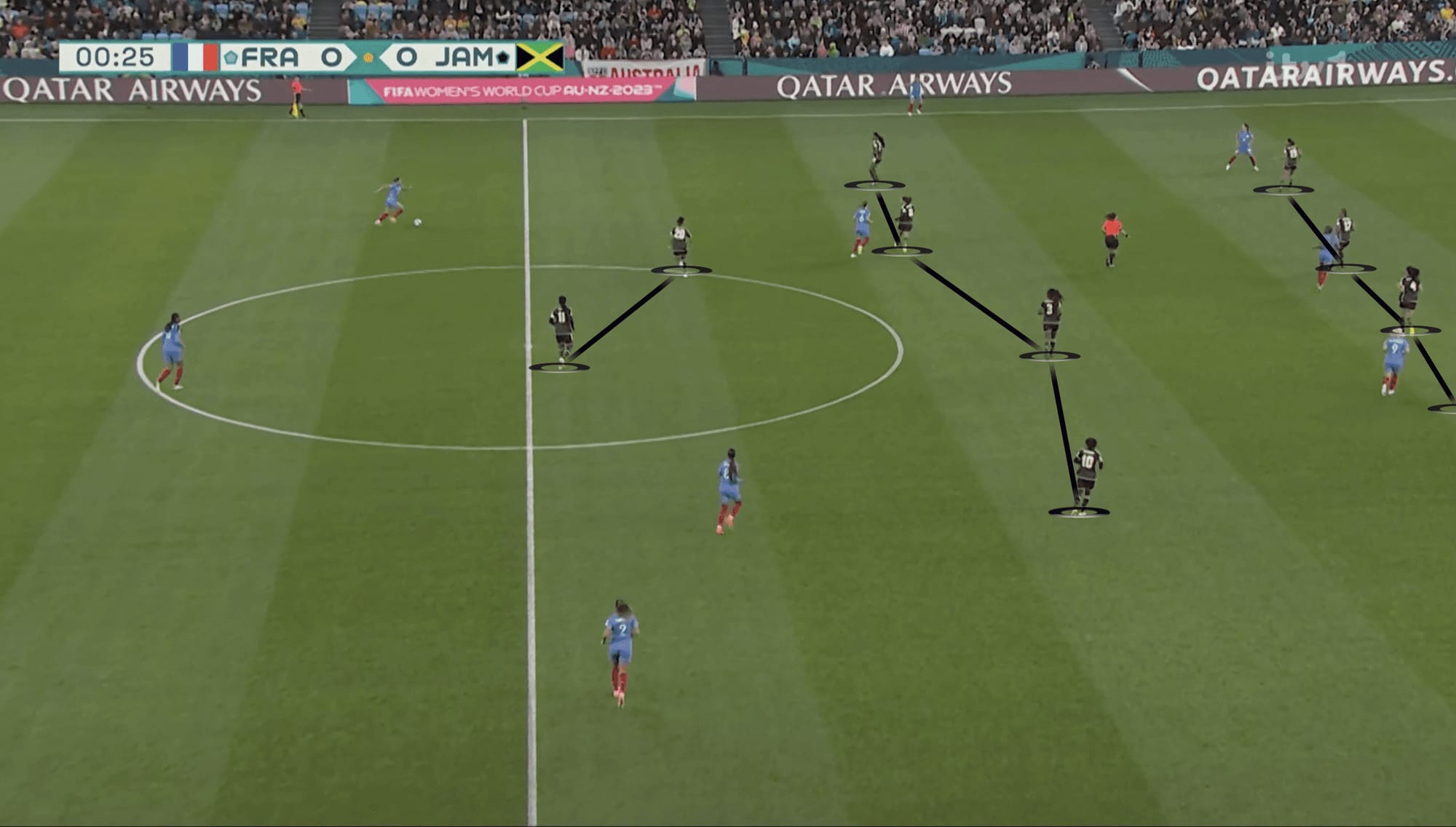
However, trying to progress the ball through the wide areas directly influences Jamaica’s formation’s structural strengths. Due to the front two’s lack of defensive aggression, they were often in positions where they could drop deeper to cover one of France’s two midfielders.
As seen in the example below, after the ball is played to the opposition left-back, Shaw drops deeper to press the opposition midfielder. As a result, cover is not reduced in the second line of defence as none of the midfielders are forced to step up and engage the opposition midfielder. Jody Kimone Brown, Jamaica’s left-winger, in their game against France, showed good awareness of the space between her and the left central midfielder, Vyan Sampson.
Brown, responsible for pressing the opposition right-back, made sure to time her press well and would only move towards the left as the pass was played to avoid passes being played between her and Sampson; this can be seen in the image below.
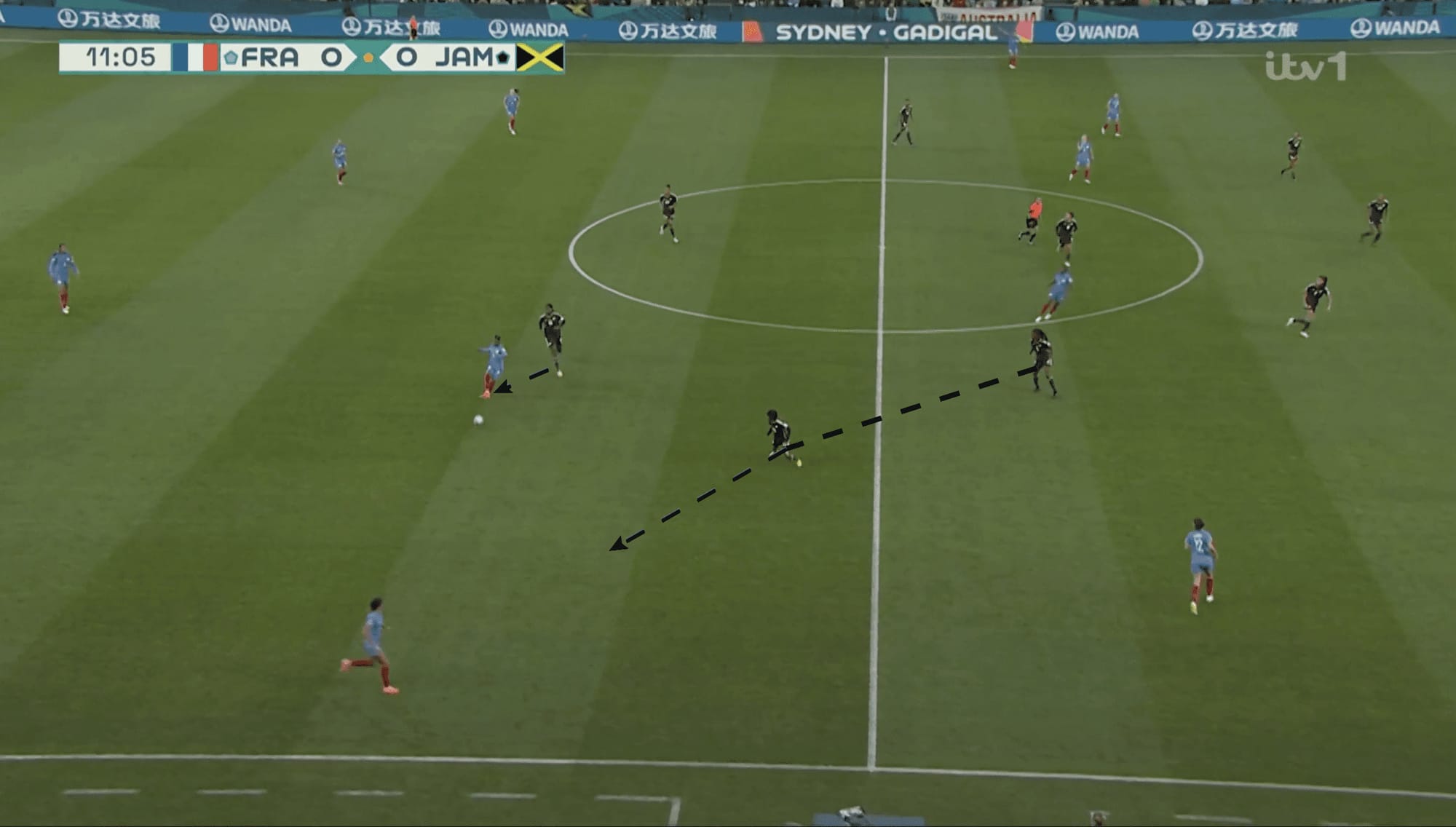
However, Jamaica’s defensive capabilities in the wide areas are not all a result of the side’s defensive structure. Another particularly fascinating aspect that this example shows is the behaviour of Jamaica’s backline.
Rather than have their left-back, Deneisha Blackwood, pushes up and presses the opposition right-back, as mentioned earlier, Brown would press the right-back, with the other two midfielders in Jamaica’s second line shifting across to cover the French players ahead of the ball.
When the opposition is in the less advanced wide areas, none of the players in the back line will look to step up in order to cover opposition players ahead of them, with this likely to prevent space opening up between them and creating potential channels for opposition players to run into.
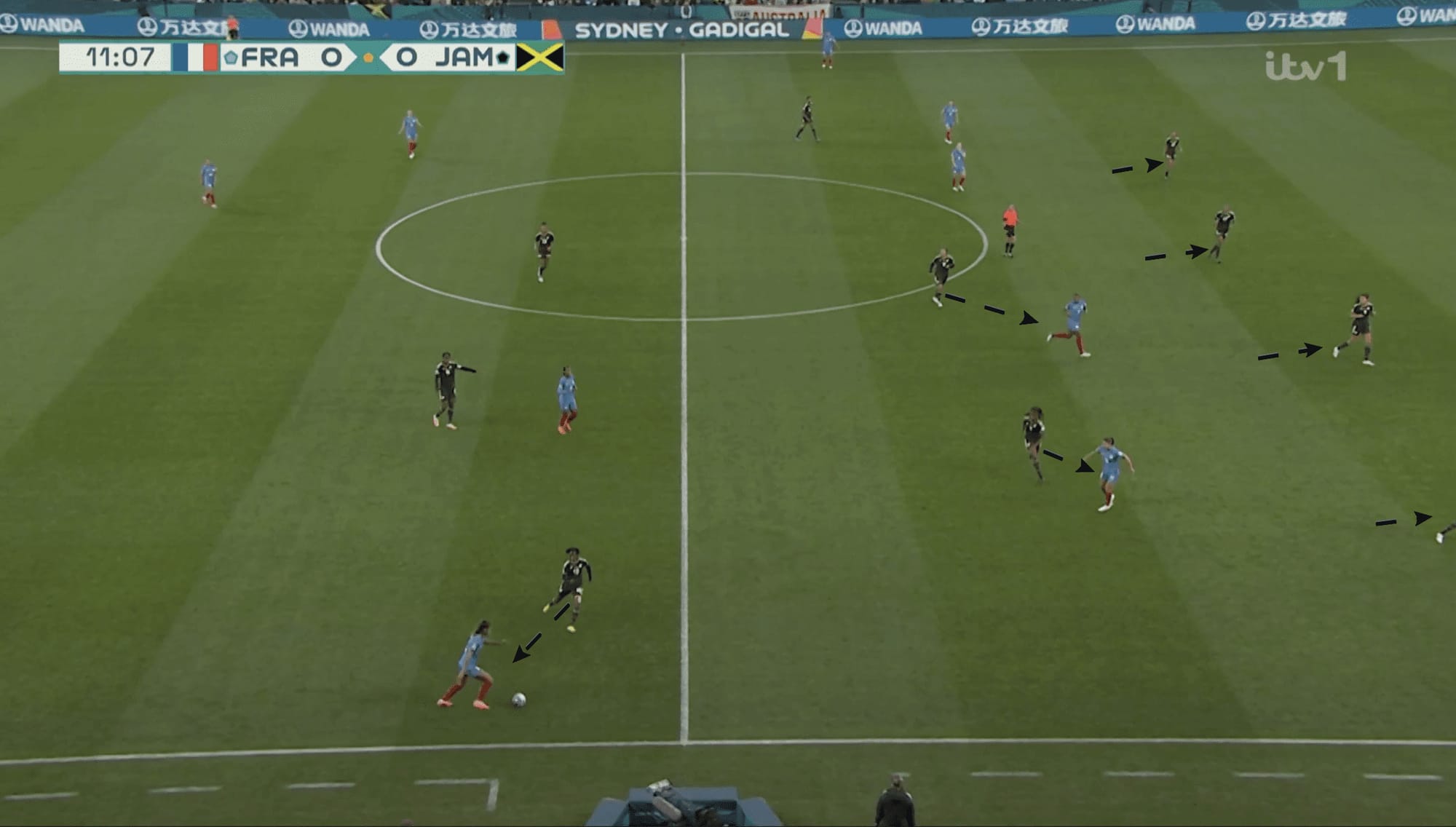
As a result of their full-backs avoiding stepping out to press opposition players in order to maintain compactness in the backline, the defensive workload of Jamaica’s wingers increases. As can be seen in the example below, both Brown as well as Cheyna Matthews position themselves in deeper positions in order to be able to cover the opposition full-backs if they receive a pass.
However, this does not mean that the full-backs never jump out in order to press opposition players in the wide areas, but they do not have to or look to do so as often due to the duties of the wingers.
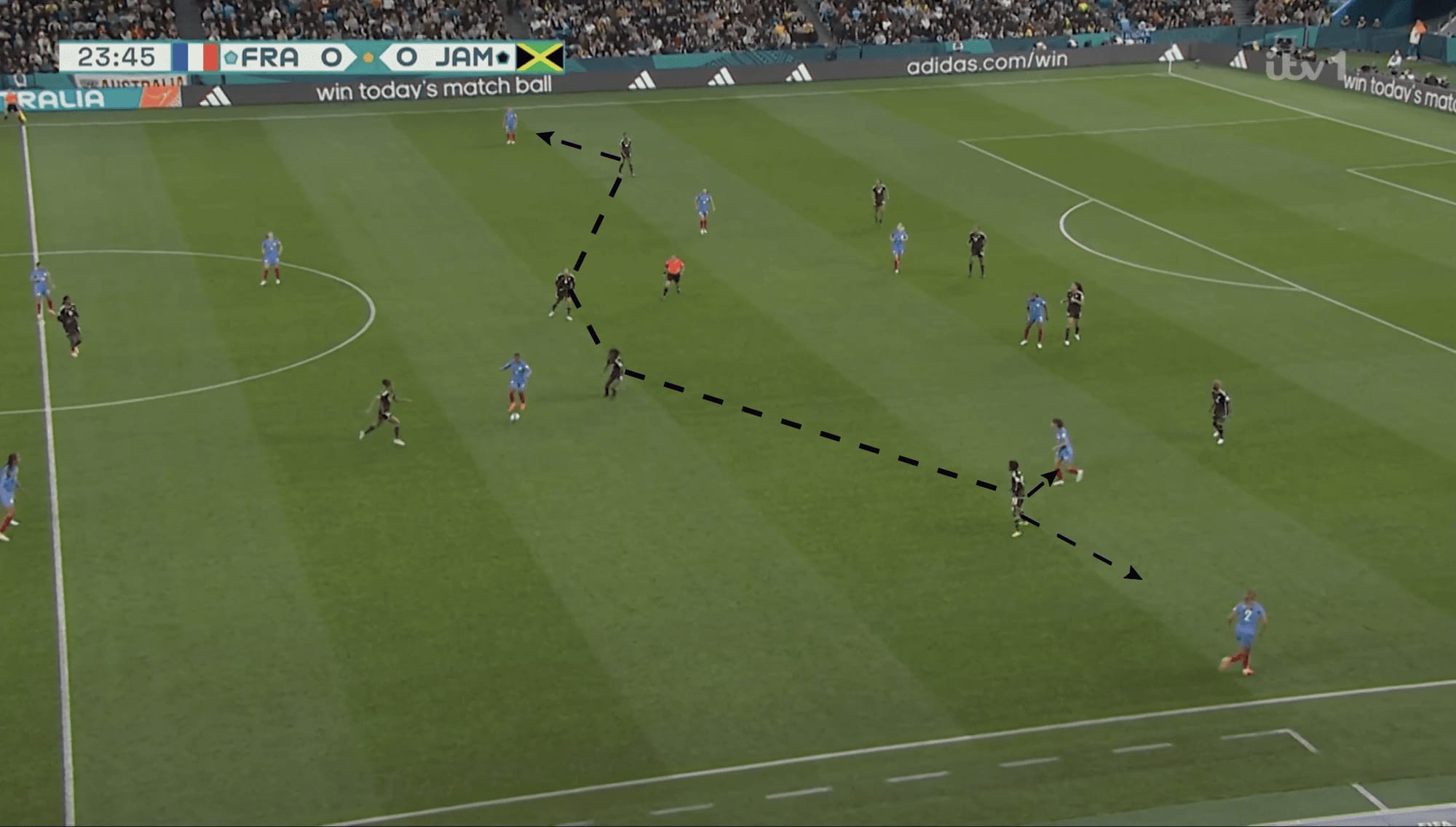
Overall, it is difficult for the opposition to advance the ball through the flanks into areas where they can cross it. Still, in this game, there were cases where France were able to gradually work themselves up the pitch either through long balls or a succession of throw-ins.
When France could reach areas where they could play in a cross, Jamaica was adequately prepared to deal with the threat. As seen in the example below, Jamaica is in a 4-1 position in the box. Due to the compactness of Jamaica’s back line, they can have three players in key positions, with the centre-back pairing of Chantelle Swaby and Allyson Swaby able to cover the near post area and the central area and Tiernny Wiltshire and Matthews able to cover the space at the back-post.
In situations where the opposition have potential crossing opportunity, Drew Spence, who plays for Chelsea in the WSL, looks to move into the central space in front of the back line. This allows Jamaica to be in positions to challenge for cut-backs and for headers at the near and far post and the centre.
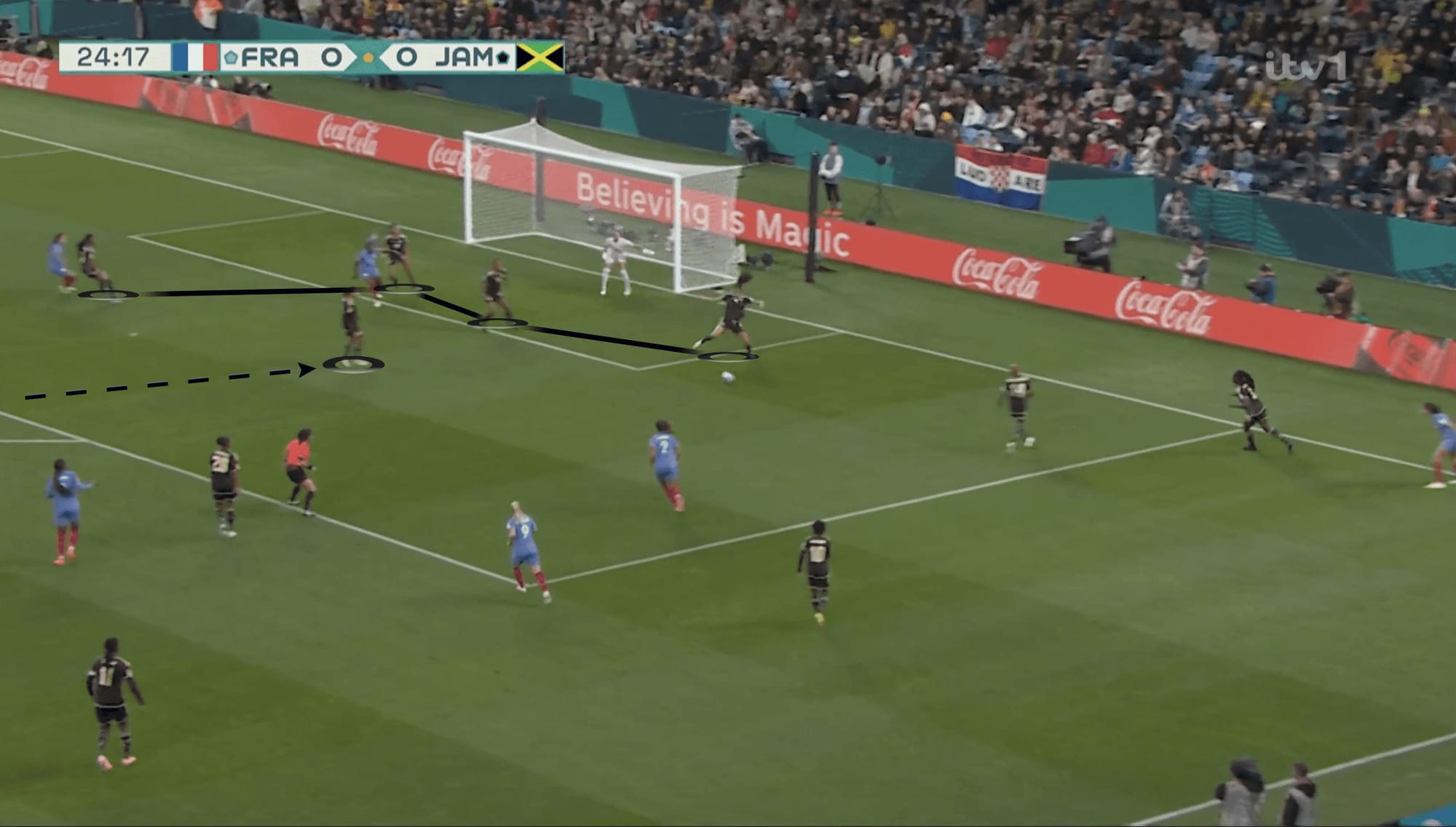
Against Brazil, Jamaica faced a similar type of challenge, with Brazil often using their full-backs as their primary means of progression; however, instead of a 4-2-4, Brazil lined up in a 4-2-2-2, with their wingers tucking in behind their front 2, with Jamaica once again lining up in a 4-4-2.
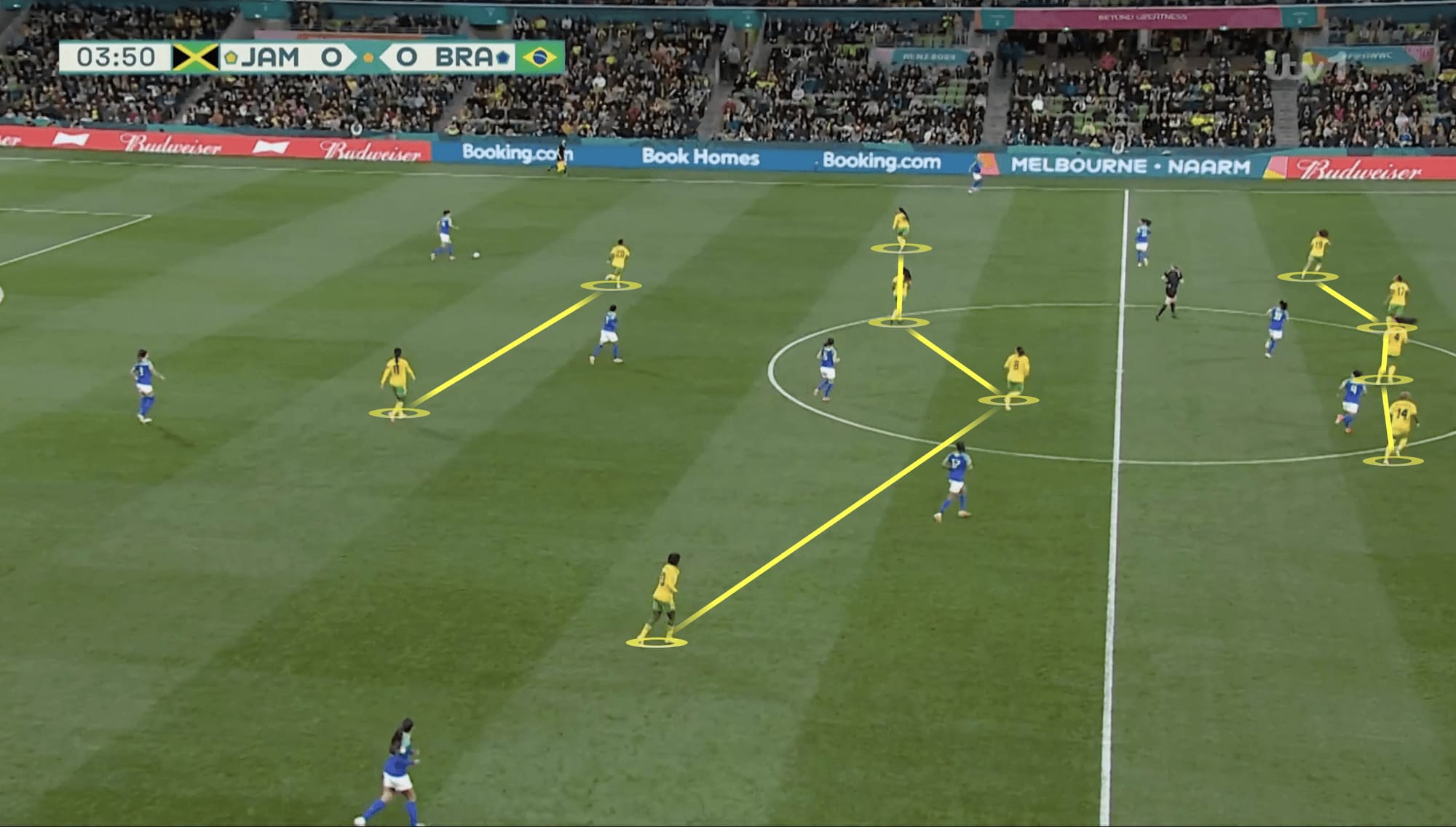
Once again, in this game, Jamaica’s wingers could drop deeper to cover the opposition full-backs, creating a 6-3-1/ 5-3-2, allowing their back 4 to remain compact. Unlike France, Brazil’s full-backs are positioned in very advanced areas, which forced Jamaica’s wingers to take up even deeper positions than they had in their opening game.
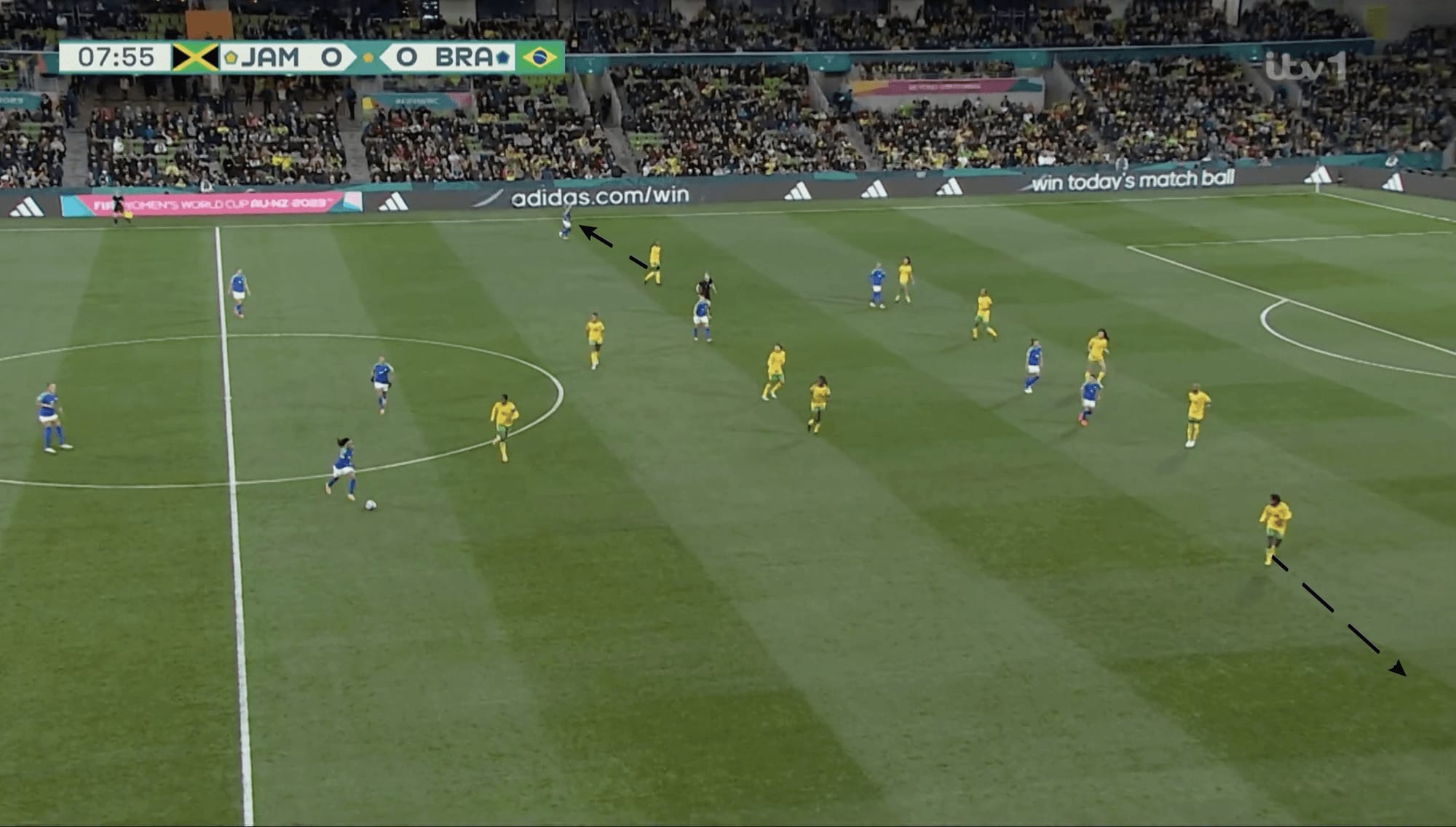
Nevertheless, as seen below, Jamaica could still adequately mitigate Brazillian attempts to progress the ball down the flanks. With Shaw dropping deeper as well as the positions of Blackwood and Brown and with the central midfielder Sampson shifting across, Jamaica can have four players in the wide areas at a time, which makes progressing the ball through the flanks with only the full-backs and one or two supporting players challenging.
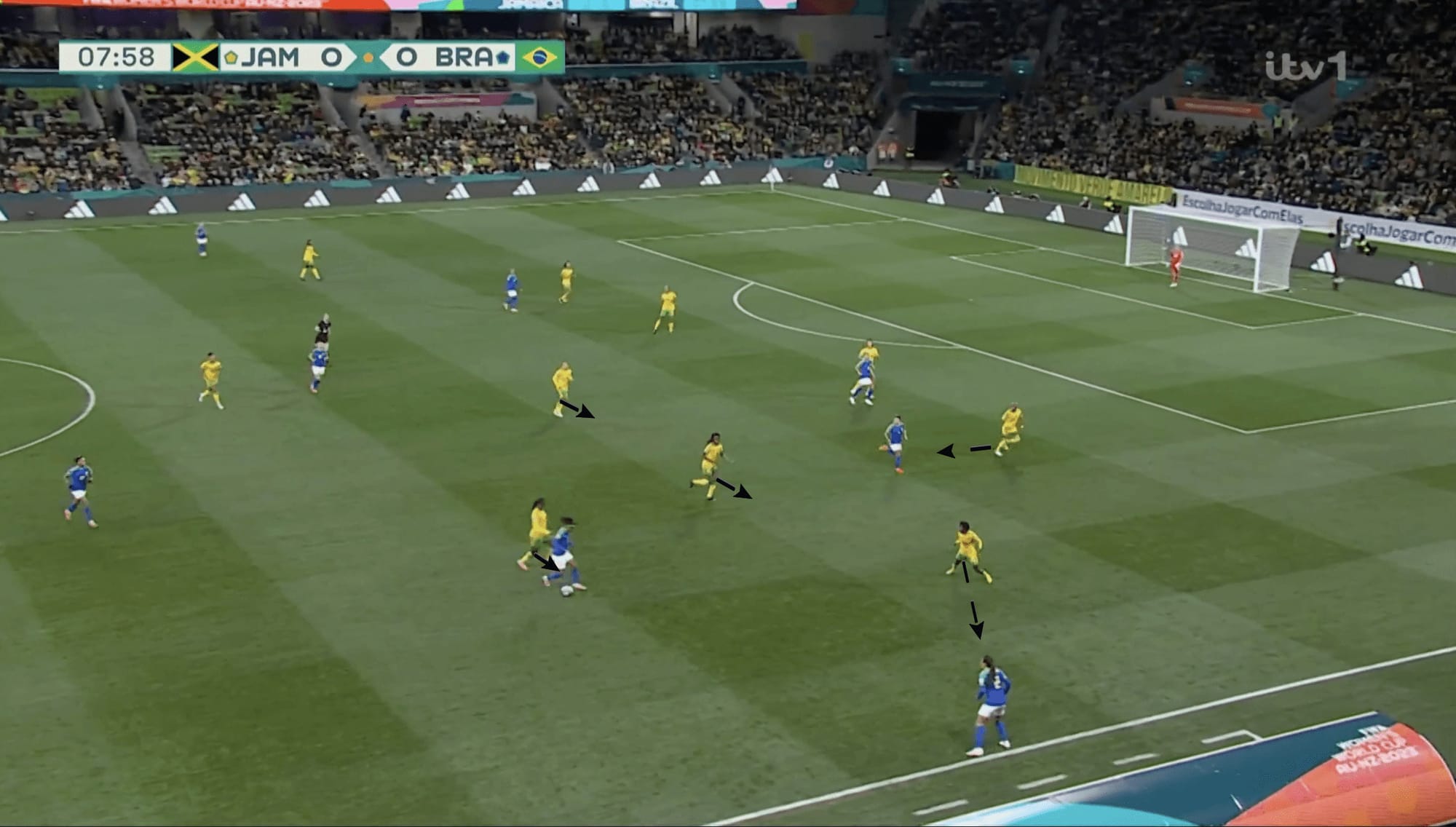
After failing to progress the ball through the right-hand side, Brazil would try and switch play to the left side. However, as seen in the example below, Jamaica’s midfield shifts well to cover the opposition players ahead of the ball, with Matthews able to press the full-back and Primus in a position where she can prevent passes into the midfield. As a result, Jamaica have a 5v3 advantage over Brazil in this area of the pitch.
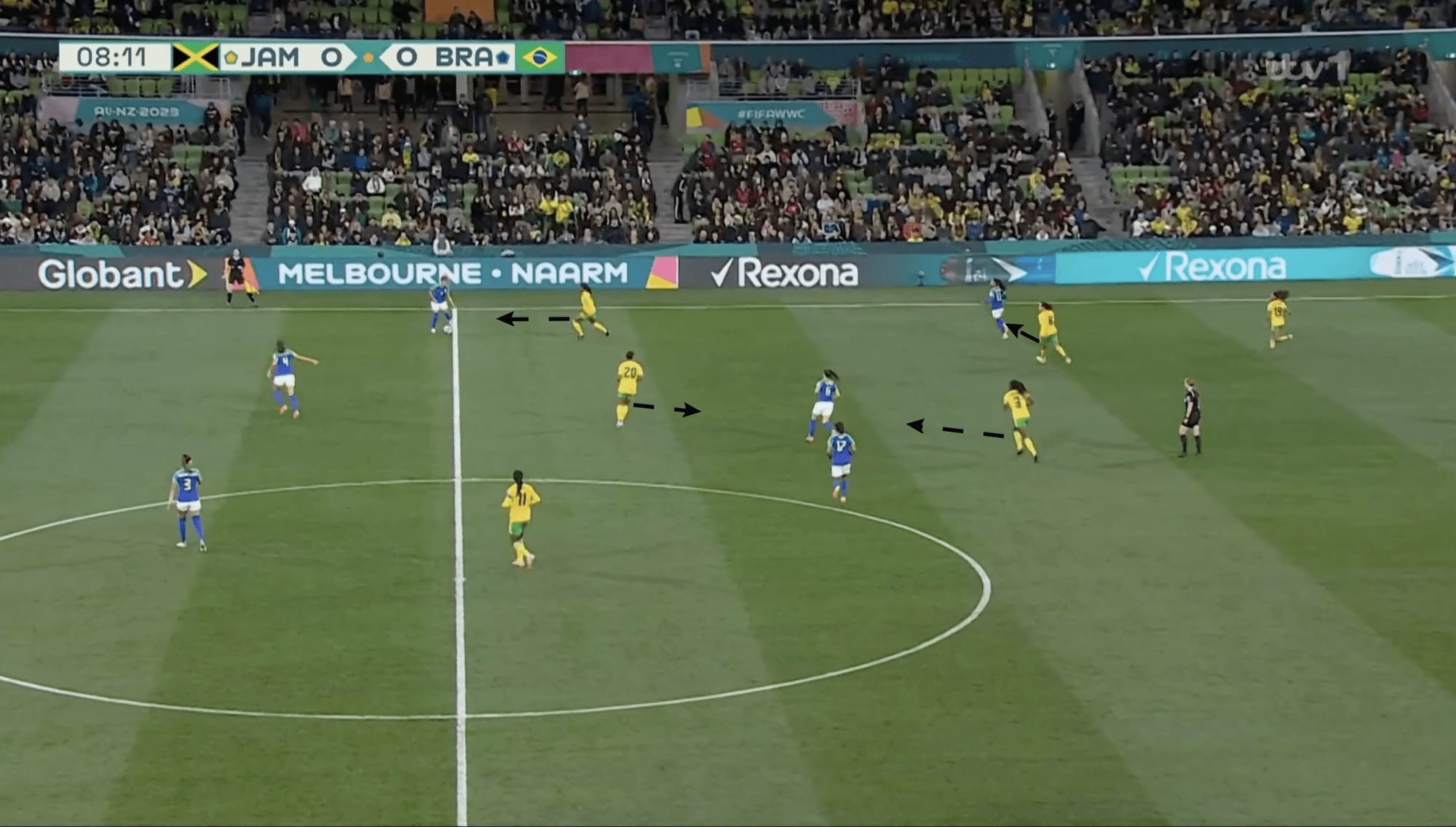
Jamaica’s weaknesses in defence
Jamaica look to commit even their attacking players to very defensive positions. As a result, they can adequately cover the wide areas and defend switches of play from one flank to the other. Looking to progress the ball directly through the wide areas is unlikely to yield consistent results.
However, instead of switching the ball from one flank to the other, teams can look to switch play from the wide areas into the central areas or to the ball far half-space. With Jamaica’s wingers orienting their positions to the high opposition full-backs, space is often created between the central midfielders and wingers.
As seen in the image below, as the opposition midfielder receives the ball, there is a large amount of space between Sampson and Brown, with Brazil’s Ary Borges drifting into the space and available to receive a pass. However, Kerolin Nicoli is not able to see this passing opportunity in time and, as a result, played the ball backwards.
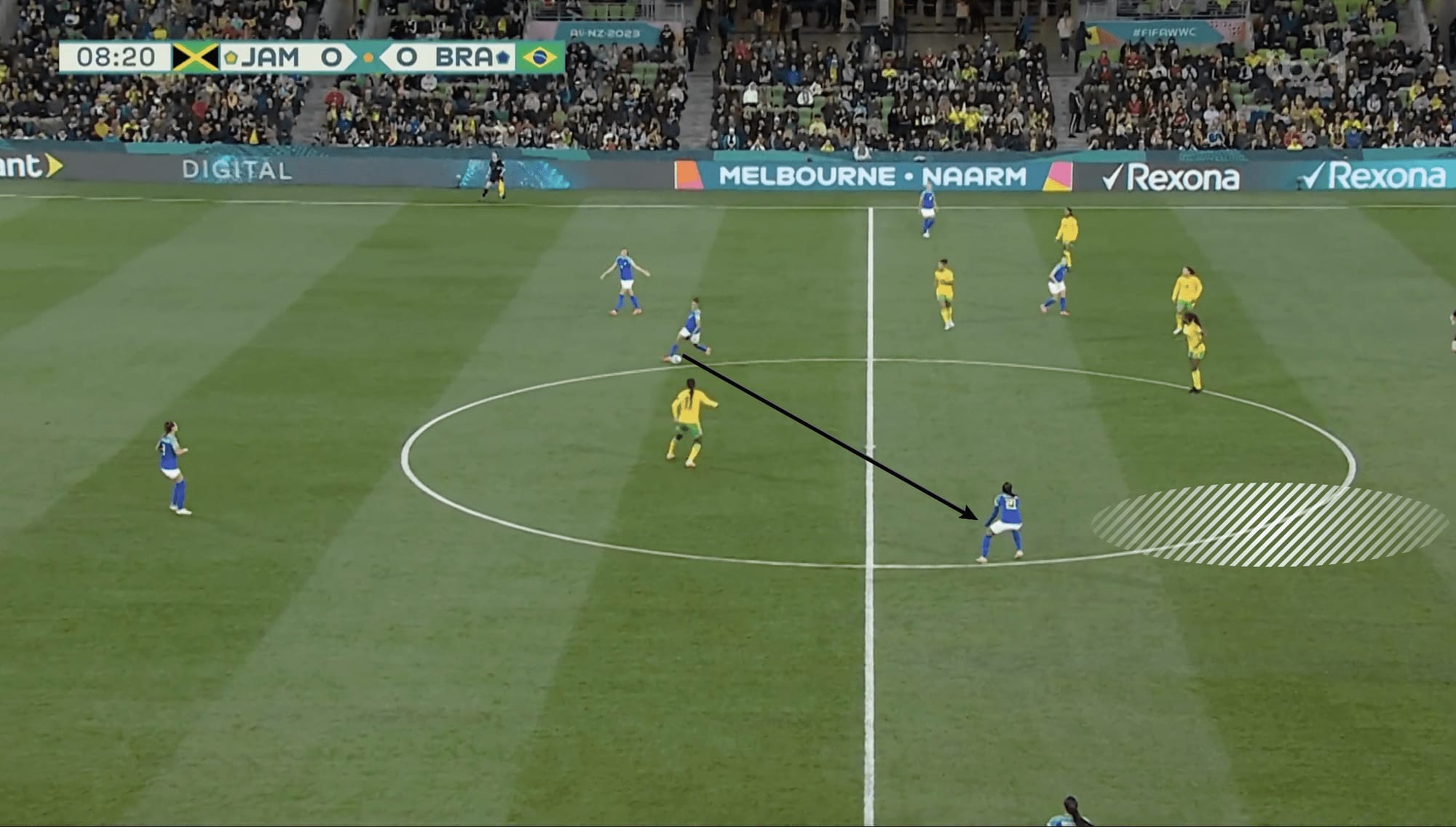
Progressing the ball through central areas and exploiting the gaps between Jamaica’s midfielders and wingers creates situations where the back line of Jamaica must step out of their line to deal with the threat. This can be seen in the image below.
With Adriana Leal receiving the ball, Swaby is forced to step out of the backline, and in order to cover the space behind Swaby, Wiltshire shifts inwards. As a result, space is created to Wiltshire’s right, giving the opposition full-back space to run into.
The left-hand side for Jamaica is particularly vulnerable as Matthews is occasionally liable to lose concentration and let the player she is marking move freely past her.
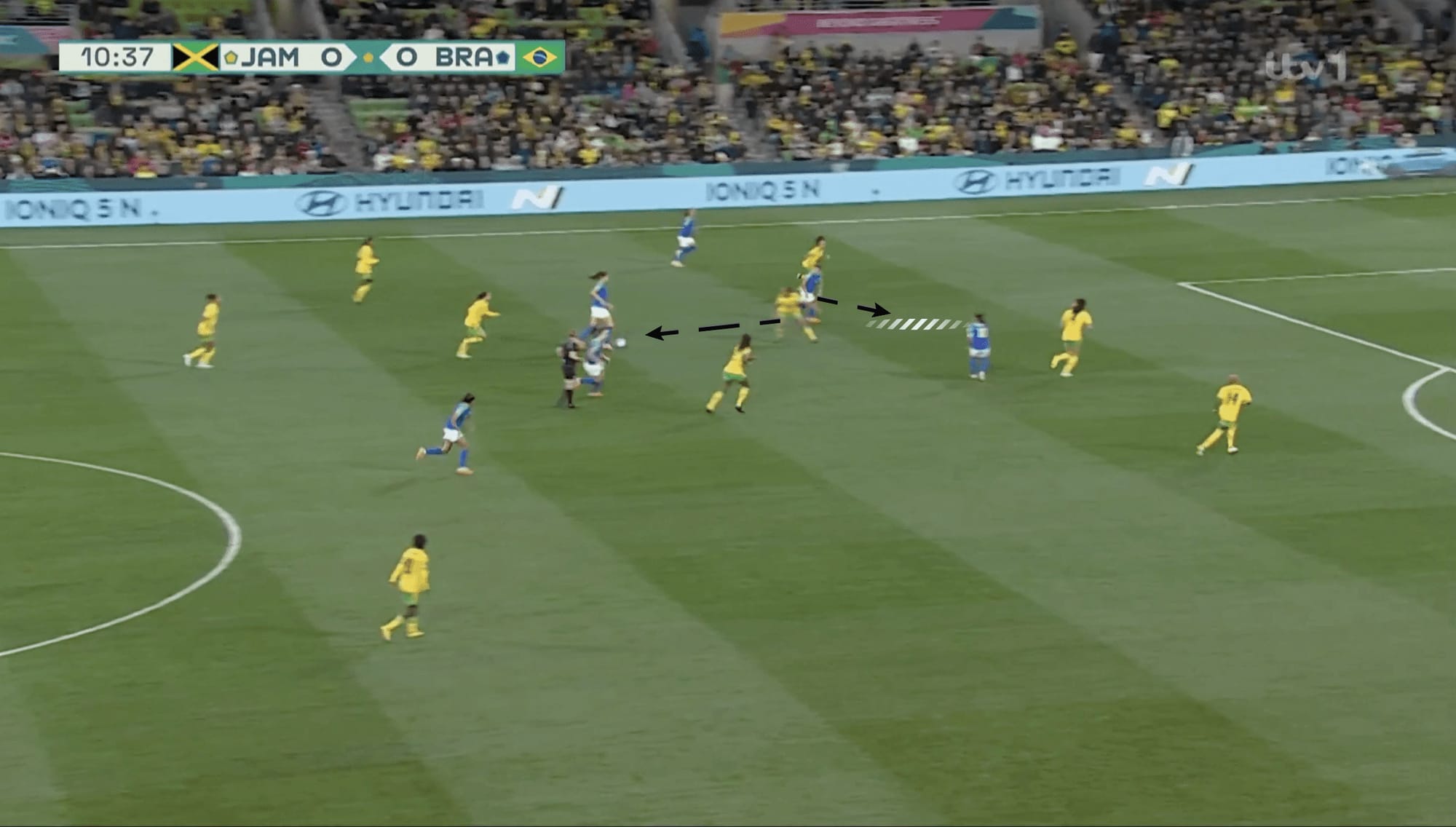
The image below shows another example of how Jamaica can struggle with progression down the middle, as the opposition centre-back can attack the space between Spence and Matthews. As a result, Swaby is forced to step out of her line, creating space for the opposition to exploit.
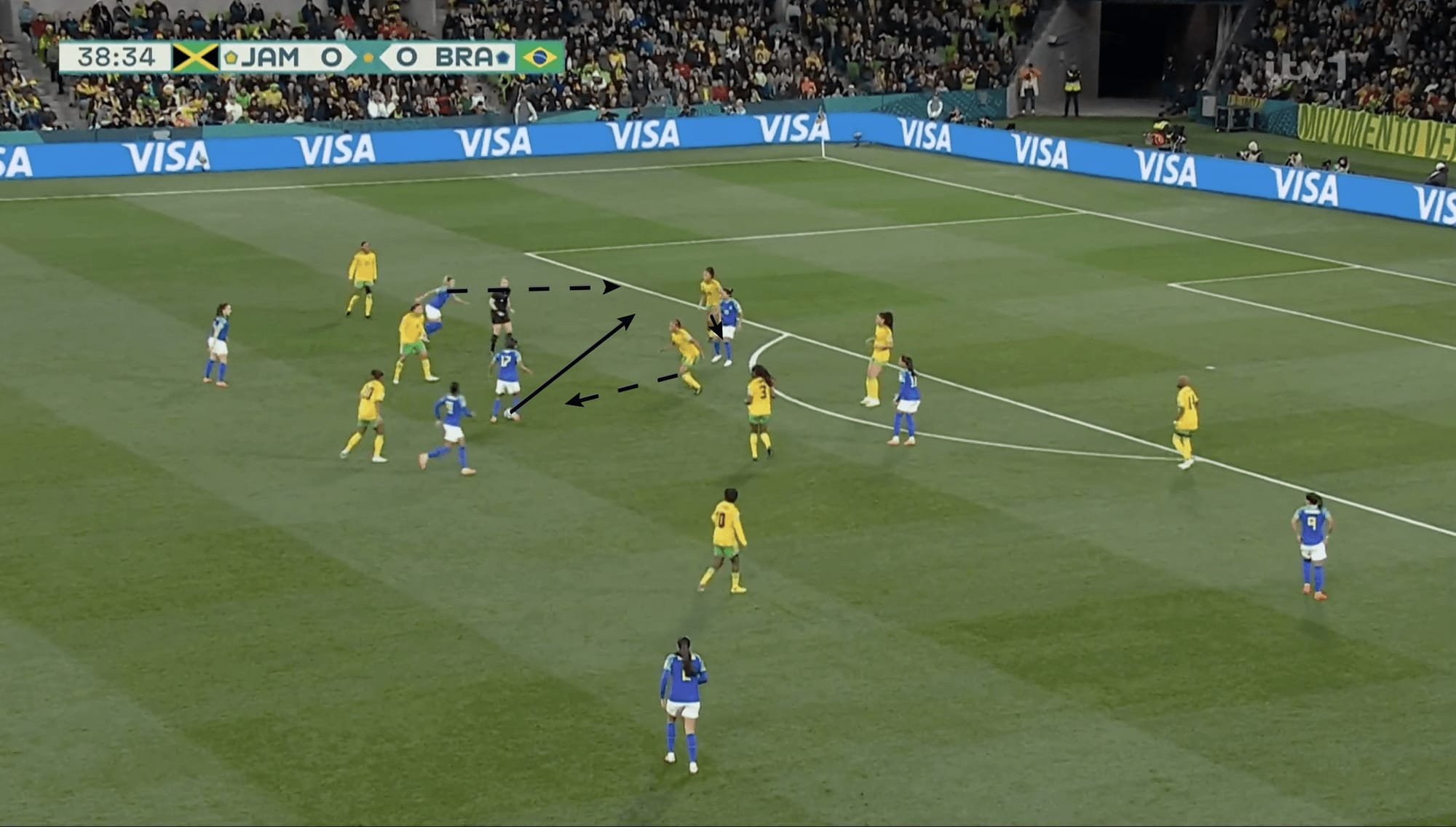
Conclusion
With all of the off-the-field issues before the tournament in regard to funding for the women’s team, it is astonishing that Jamaica have been able to reach the knock-out stages for the first time in their history.
This analysis has looked to provide insight into why Jamaica have been able to shut out some of the top teams in the world but has also addressed some deficiencies in their game that may be taken advantage of if they are not ironed out before their game against Columbia in the coming week.




Comments